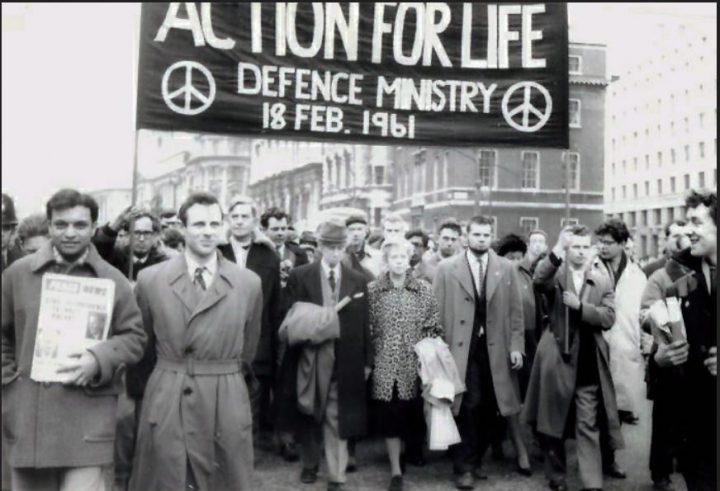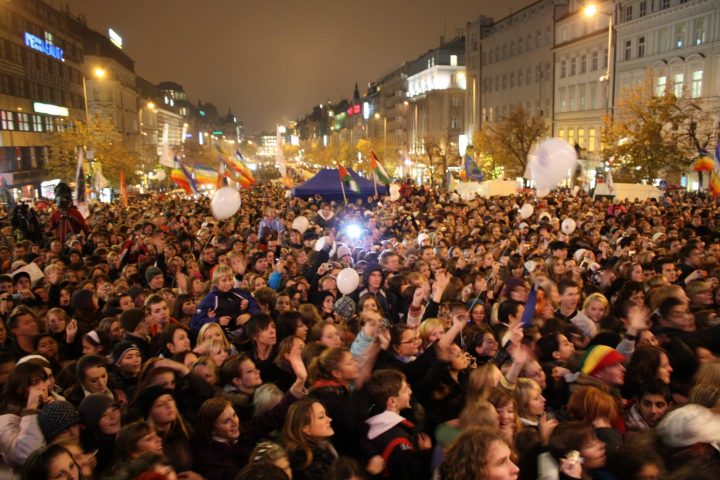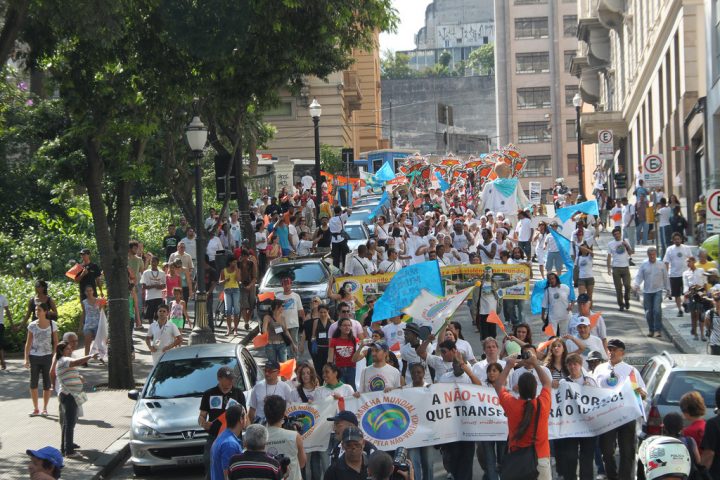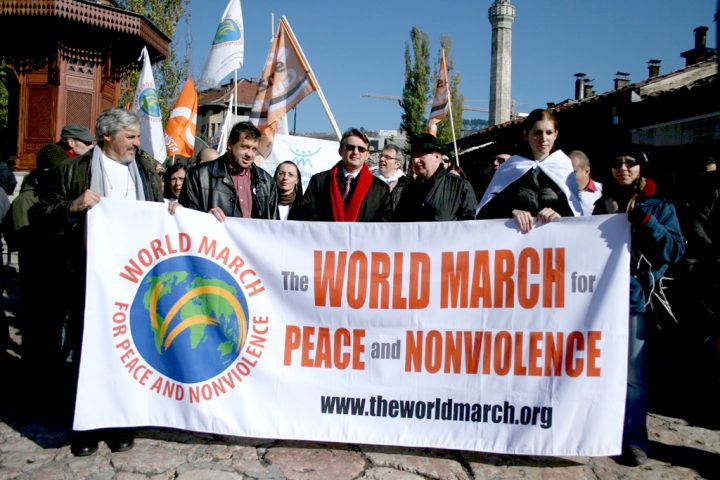By Duncan Meisel, September 5, 2017. for Waging Nonviolence
The Trump administration is reviving the threat of nuclear war in a way that no other U.S. presidency has done since the Cold War.

Bertran Russel leading an antinuclear protest in 1961
While the confrontation with North Korea’s expanding nuclear and ballistic missile program has taken center stage, Trump’s ham-fisted engagement with Taiwan, missile strikes against the Russia-linked Assad regime in Syria and the rapid push for a nuclear weapons modernization program all contribute to a new and unique climate of nuclear threats.
It’s easy to feel disempowered in the face of such chaotic and consequential decisions, but the history of nuclear weapons since 1945 is one of extensive and frequent interventions by organized people in the United States and other countries to stop nuclear weapons deployments and nuclear war itself.
No one knows this history better than Lawrence Wittner, professor of history emeritus at SUNY/Albany and author of the three-volume work “The Struggle Against the Bomb.” His work explains how — time and again, for over 50 years — one the world’s largest social movements used globally organized outrage to pull leaders with little moral compunction back from the brink of using the deadliest weapons on earth.
I recently spoke with Wittner about his seminal research to gain a better understanding of how the nuclear disarmament movement organized its most successful campaigns, how the world might be different without them and the lessons they offer a new generation that seeks to make the world a safer, saner place.

World March for Peace and Nonviolence 2009-10
How determined were military leaders to use atomic weapons in various conflicts during the Cold War?
They didn’t take nuclear war lightly, but they certainly considered using nuclear weapons many times. Of course, the U.S. government used them rather casually during the Second World War. Japan was on the verge of surrender, and numerous U.S. military leaders told President Truman that he should not use them — including Gen. Eisenhower.
Once Eisenhower came to power, his administration developed the policy of “massive retaliation,” which meant that any aggression — nuclear or conventional — by the Soviet bloc in Europe would be met with nuclear war. The NATO policy was to respond to a conventional invasion of Western Europe with a nuclear first strike.
Use of nuclear weapons was considered by the Eisenhower administration during the Korean war and in defense of Chiang Kai-Shek’s Nationalist regime on Taiwan and other offshore islands. During the Vietnam War, the Nixon administration talked rather casually about waging nuclear war in Vietnam — or at least Nixon did. He ran this by Kissinger, who was horrified, but Nixon said he was just trying to get him to think creatively.
Then there was the case of the Reagan administration, which came into office talking quite glibly of waging nuclear war and was met by massive opposition.
What stopped government officials from taking nuclear action?
I think their inclinations were challenged and blunted by popular protest against the bomb, which had made nuclear war so abhorrent to the public across the world, including in the United States, that they backed off their plans.
There were several retreats from the hawkish positions government officials had taken, and in some cases a dramatic turnaround. The Eisenhower administration never planned to halt nuclear testing since it assumed that U.S. national security was based on making advances in nuclear weapons. However, in 1958 — when it was boxed in by popular protest against nuclear testing — the administration halted U.S. nuclear testing without any treaty, and began negotiations with the British and Soviet governments on a test ban treaty.
During the 1950s, Eisenhower was confronted by Defense Department officials who said they had to get ready to use nuclear weapons to win small wars. They had long feared they couldn’t win a war in Asia fought with conventional weapons, and that was true — and therefore the only way they could win it was by employing nuclear weapons. Eisenhower and [Secretary of State] John Foster Dulles both responded, essentially: “We’d like to give you a green light, but the public won’t stand for it.”
In his book “Danger and Survival,” McGeorge Bundy — national security advisor to Kennedy and Johnson and an occasional advisor to Nixon — said that the U.S. government didn’t back off waging nuclear war in Vietnam based on the fear of retaliation by the Soviet Union or China, but rather because the world public wouldn’t stand for it. Popular opinion against nuclear weapons was so strong, the U.S. government would lose more than it would gain by using them. The public in the U.S. in particular wouldn’t stand for it.
The most dramatic example, however, involves the Reagan Administration. Reagan came to the White House as a very hawkish candidate, talking glibly about waging nuclear war. He had opposed every nuclear arms treaty signed by his predecessors. But thanks to the massive nuclear freeze campaign in the United States and the disarmament campaigns overseas, he retreated, and ultimately he adopted nuclear disarmament as a key part of his public policy. He began to say that a “nuclear war can never be won and must never be fought,” which was clearly an attempt to head off a popular movement.
What were the things that drove peaks of mobilization against nuclear weapons? How did organizers take advantage of geo-political developments to grow?
The atomic bombings of Hiroshima and Nagasaki were very dramatic, and they were the most significant factors generating initial disgust with nuclear weapons and the desire to abolish them. The fear of nuclear war was great after 1945, and the groups that formed in those first years played on the horror of the bombings and their devastation.
The second dramatic growth took place in late 1950s and early 1960s, largely due to hydrogen bomb tests. They were symbolic of doom in two ways. First, they were a quantum-leap forward in power: They could be made a thousand times as powerful as the bomb that destroyed Hiroshima. The public testing of these weapons symbolized the fate of the world, if they were ever used in war. And who could say they wouldn’t be?
Also the H-bomb tests themselves were sending vast clouds of fallout around the world. The scientist Linus Pauling estimated that 1 million people would die from fallout unless tests were halted. For many people nuclear war was rather abstract — it wasn’t being waged against them. But these explosions were occurring all the time, and people were being bombarded by radiation that was causing birth defects and cancer. Therefore, it wasn’t just war they had to fear, but the tests themselves.
Another mobilization peak took place in the late 1970s through the early 1980s, and that developed out of the revival of the Cold War that seemed to be on the decline after 1963. But Cold War détente was swept away by Reagan in the United States and Thatcher in Britain and Soviet leaders building new nuclear weapons and talking rather glibly about waging nuclear war. Peace groups could play on this theme and assail Reagan in particular as the “Mad Bomber,” the man who would unleash nuclear war. In place of nuclear threats and weapons buildups, peace groups demanded a halt to the nuclear arms race as the first step in building a nuclear weapons-free world.

Conversely, what accounts for the valleys of organizing? When did the movement shrink?
The fear of nuclear weapons hadn’t gone away by the late 1940s, but there was little hope of getting rid of them thanks to the heightening Cold War. People also feared speaking up in the climate of being labeled subversives.
Another decline came after 1963 when there was growing public complacency thanks to the signing of the Atmospheric Test Ban Treaty. There was also the Vietnam War, which drew people’s attention away from the nuclear conflict and towards the U.S. government’s assault on this poor, third world nation. The major constituency for the nuclear abolition campaign was the peace movement, and the peace movement had moved to focusing on Vietnam. A lot of people simply turned away from the disarmament campaign and assumed their governments were solving the nuclear problem and could deal with other issues.
A third decline came in the late 1980s, and has continued right up to the present. That was based to some degree on complacency — after all, the U.S. and Soviet governments had resolved their differences, signed treaties, the Cold War came to an end, and the fear of nuclear war went down. But there was also some degree of exhaustion: By the late 1980s people had been campaigning for a decade or more, and so there was a desire to cultivate one’s own garden and let world leaders deal with the remaining nuclear dangers.
A common thread running through the entire post-1945 period is that people don’t want to think about nuclear war. When they’re forced to think of it, when they can’t escape it, they want to stop it. But when it’s not in the headlines any more and governments are growing more reasonable, they’d just as well not think about it. If nuclear war did break out today, you can bet more people would focus on it, but, of course, we don’t want that war to have to take place.
The peace movement’s challenge is to maintain its momentum and sense of danger — even though the world might seem safer and there are fewer nuclear weapons in the world. If the nations of the world are maintaining their arsenals, the struggle hasn’t come to an end.
Do you think the moment we’re experiencing today with Trump and North Korea is potentially a driving force for another peak of movement energy? What’s different today?
It’s possible that there will be some revival of the nuclear disarmament movement, but we haven’t seen the surge of resistance yet. I’m a co-chair of the national board of the group Peace Action, so I’m very well aware of how peace groups are doing. While Peace Action isn’t doing badly, we’re certainly not yet experiencing the surge of action in the streets, such as when its predecessors, SANE and the Nuclear Freeze Campaign, were taking off.
One reason it’s not taking place is that the mass media rarely focus on the danger of nuclear war, and when they do focus on it, it’s the danger of some other country waging war on the United States. One day it’s Iran, another day it’s North Korea — but they don’t seem to get to the basic problem that nine countries have 15,000 nuclear weapons in their arsenals. It’s a worldwide phenomenon, as is the persistence of the idea of nuclear weapons as the ultimate guarantor of national security.
Right now there’s also a sense that only Koreans are vulnerable, that most Americans aren’t at risk of being bombarded by nuclear missiles. At the height of popular protest in the 1980s, millions of people were in the streets — in part because U.S. and Soviet arsenals could reach both sides quite easily. That got people to wake up and realize that nuclear war wasn’t such a hot idea after all.
How big a role did fear play in these spikes of organizing? How can people dealing with fear of the Trump administration, or of North Korean nuclear mobilization, help direct that energy into making nuclear conflict less likely?
I think fear has probably been the most important factor in mobilizing people. When you look at things psychologically, people should be afraid of nuclear weapons and nuclear war. It seems irrational to go bury your head in the sand and not worry about them.
But it’s also true, in two ways, that fear is dangerous. One is that it can be demobilizing, that people get so scared they’re scared silent. They become so frightened they retreat and they don’t feel powerful any more. They might take drugs instead of taking action.
A second danger is that, if people are scared of nuclear war, the hawks have an answer for them. They turn fear on its head: Yes, they say, nuclear war could be a bad thing, that’s why we need nuclear weapons to deter the bad Russians, Iranians, North Koreans and so on. This means fear may reinforce the desire for nuclear weapons rather than for getting rid of them.
For these reasons, the use of nuclear fear has to be very careful. Peace activists have to make the case that as long as nuclear weapons exist there’s no real security from nuclear war, and therefore we need to get rid of nuclear weapons. That’s the best case that can be made by nuclear disarmament forces: The arms race is a race no one wins.
What are some of the forgotten “paths not taken” of weapons not built or decisions not made as a result of anti-nuclear organizing? How might the world be different if those things had been built?
The neutron bomb was being proposed during the Carter administration. This enhanced radiation weapon was designed to destroy people rather than property, and was scheduled by the Carter administration to be deployed in Western European nations. But once peace groups learned of it and began to focus on its terrible effects, this caused massive protests in Western European nations and, eventually, an unwillingness to support the neutron bomb deployment by their government officials. As a result, the Carter administration finally concluded that, if Western governments weren’t willing to stand up for it, the U.S. government wasn’t going to be the villain of the piece. So Carter canceled plans for its deployment.
The MX missile was the jewel in the crown of the Reagan administration during its first term of office. Peace groups said that it was a first-strike weapon, and there was so much popular protest against it that Reagan couldn’t get funding through Congress. Eventually, a plan that began as 200 missiles barely slipped through with 50 missiles. That failure became the basis of the U.S. government’s push for strategic arms reduction treaties, for it meant the U.S. government couldn’t keep pace with development of intercontinental ballistic missiles. And the next best thing was seeing to it that neither country had those weapons. The best way to do that was to sign a treaty: the Strategic Arms Reduction Treaty, or START, which Gorbachev welcomed and showed him, in many ways, to be a peace person, strongly influenced by the movement.
Gorbachev had his own peace-oriented ideas, but he also received a large amount of information from the disarmament movement in the United States and around the world. He would take time out of his meetings with heads of state to meet with representatives of groups like the Freeze campaign, SANE, and International Physicians for the Prevention of Nuclear War. So, Gorbachev and Reagan’s detente and the overall drawback from the nuclear brink were heavily influenced by the peace movement — not just through public pressure but also through direct engagement.
Are there other potentially winnable campaigns of this kind available to anti-nuclear weapons activists today that might limit the likelihood of the Trump administration using nuclear weapons?
It seems to me there are two ways to develop mass pressure on Trump and Congress in connection with the general problem of nuclear weapons.
The first has to do with the trillion dollar nuclear “modernization” program — the plan to upgrade the entire nuclear weapons complex, build new bombers and missiles and submarines and so on. That cost is so great that it provides the opportunity to reach people who are already concerned about the arms race or are satisfied with the weapons we already have and don’t want to bankrupt the country. So you can make demands for cutbacks in the “modernization” plan or stopping it entirely and mobilize a sympathetic constituency.
A second way is to focus on Trump’s mental instability: The fact that he’s a reckless, dangerous leader, who really shouldn’t have the button to launch nuclear war in his hand. That’s what the currently proposed Markey-Lieu bill seeks to address: Under its provisions, unless there’s a nuclear attack on the United States, the president cannot initiate nuclear war without a Congressional declaration of war. Since Congress hasn’t declared war since 1941, that’s a pretty big restriction.
Sen. Markey also introduced the SANE act, which provides for a massive cutback in the trillion dollar nuclear weapons program. These are two bills that Peace Action is supporting right now.
What role did collaboration with people on the frontlines of nuclear weapons production, testing and usage play in the successes of the movement?
Hibakusha, the victims who survived the Hiroshima and Nagasaki bombings, have played a very significant role — their testimony and example inspired people around the world.
Certainly, atmospheric nuclear tests, which were sending vast clouds of fallout around the world, had a major impact in terms of people nearest the sites. People in those communities in Nevada and Utah grew very wary and filed lawsuits against the federal government for damages.
Groups of veterans got together and formed atomic veterans associations, for many members of the armed forces had been sent to testing sites to get them ready for nuclear war. They were given very little protection. When they began to die from cancer or had children with birth defects, they filed lawsuits. This became another major headache for the U.S. government, and helped expand the constituency of the nuclear disarmament movement.
Then there were people working at or near uranium mining sites. Massive cancer outbreaks occurred among miners, who were often Native Americans. Their sacred land was being polluted and destroyed, and they began dying of cancer. They told horrifying stories and linked up with the nuclear free community movement.
Nuclear weapons production sites contaminated vast regions: the Hanford Nuclear Weapons Site is a nightmare. Finding something to do with nuclear waste is still a major problem. People living near these sites provided a massive cancer cluster, suffered terribly from the nuclear production process, and became active in the anti-nuclear campaign. By the 1980s and 1990s there were campaigns in these communities working in cooperation with peace groups that shut down many of these production sites.
The most stunning success, in my opinion, of the anti-nuclear weapons movement is the push for a Nuclear Freeze and the effect it had on ending the Cold War. What happened through the ’80s with the Nuclear Freeze movement and how did that contribute to the end of this incredibly deadly standoff?
I should start by saying that while there was certainly a very powerful Freeze movement in the United States, the movement in the rest of the world was not based on a nuclear freeze — it was based on abolishing nuclear weapons. There was some tension between the Freeze campaign in the United States and the other movements, such as Campaign for Nuclear Disarmament in Britain, which called for banning the bomb.
The Freeze was a bilateral halt to the testing, development and deployment of nuclear weapons by the Soviet Union and United States. It was proposed by Randall Forsberg, who was a defense and disarmament expert. She wanted some kind of focus for the movement, which was engaged in diverse projects at the time. So she proposed the Freeze idea to a variety of peace groups and, though some of the more militant peace groups were wary, the major ones went for it and meetings spread to localities across the United States.
Different groups contributed their resources to it, but there was also an independent Nuclear Weapons Freeze Campaign that developed. It began to introduce and win propositions in favor of the Freeze in local town councils and state legislatures because people thought it made perfect sense. Polls showed that 72 percent of the American public backed it. Occasionally, these ballot propositions and city resolutions failed, but they mostly passed. Dozens of states, hundreds of towns, associations and groups that hadn’t otherwise taken a stand on foreign policy in the past endorsed the Freeze. Members of Congress introduced resolutions into the House and Senate — which the movement actually thought was premature — and the Freeze passed by a substantial majority in the House but not in the Senate, where it was blocked by Republicans.
In subsequent years, the Reagan administration was driven back from its hawkish stance and entered disarmament negotiations with the Soviet Union. While there was no formal Freeze, there were governments that refused to accept cruise and Pershing II missiles. There were governments demanding the United States and Soviet Union get together to disarm. The Reagan administration felt itself besieged and began moving towards signing arms control and disarmament agreements.
Testing and deployment was stopped and — under the Intermediate Nuclear Forces Treaty signed in 1987 — cruise and Pershing II missiles, as well as Soviet SS20 missiles, were banned from Europe. This was followed by the START treaty, which reduced ICBM numbers on both sides. Before long, Gorbachev and Reagan were strolling around Red Square talking about what good friends they were, and it was by and large the movement that was responsible for that.
What do you think kept the anti-nuclear movement from achieving its final goal of disarmament? What is the lesson for us today?
First, we should recognize that there’s been great success in reducing weapons arsenals from their high point of around 70,000 weapons to less than 15,000 today. That’s still 15,000 too many — but, nonetheless, looked at over time, that’s a real gain.
The central problem, though, is that for thousands of years there’s been a reliance on violence and war to solve disputes between competing groups. The assumption among government leaders is that the bigger the weapon, the more security you have — and the public often agrees. How do we counter that? The answer is to develop nonviolent organizations and global institutions that can provide other kinds of security for people.
Nonviolent resistance has been developed over time and popularized by Gandhi and the U.S. civil rights movement. That’s one way for people to engage in social struggle without killing other people or otherwise harming them.
On the international level it’s vital to have institutions that get nations to back off from conflicts with one another and resolve them short of an arms race and war. It means developing a stronger United Nations that can work to, and hopefully resolve, international disputes.
As long as people feel insecure, they’re going to be reluctant to give up their weapons and the option of violence. So we need to develop alternative means of security.
What do you think is next for people working against nuclear weapons? What are your hopes for the future?
I’m a historian. I’m much better at talking about the past than predicting the future. So, I’ll focus on what I’d like to see happen. In my opinion, critics of nuclear weapons should convince other people that nuclear weapons provide more problems than they solve, that they are counter-productive. They should convince people that there are better ways to foster security than building nuclear weapons, threatening to use them, and employing them in war. If enough people devote themselves to the nuclear disarmament campaign, we can create a nuclear weapons-free world and prevent nuclear war. We’ve come part of the way, and we should finish the job.






